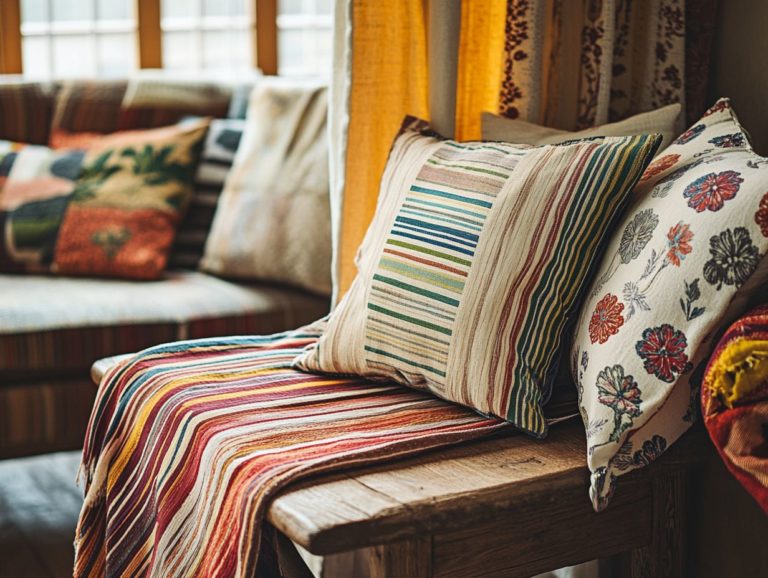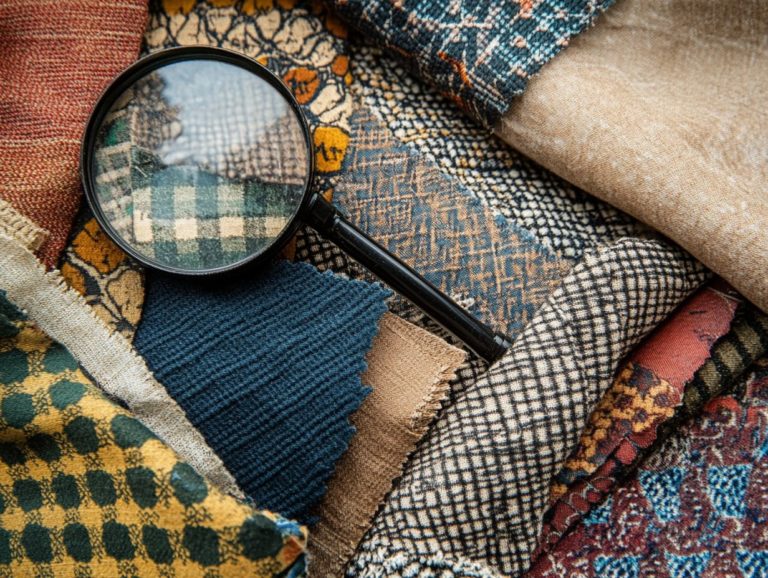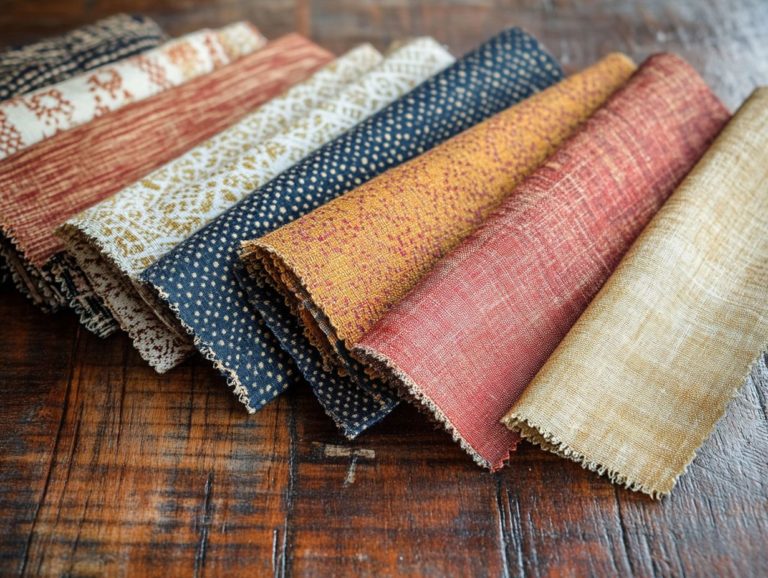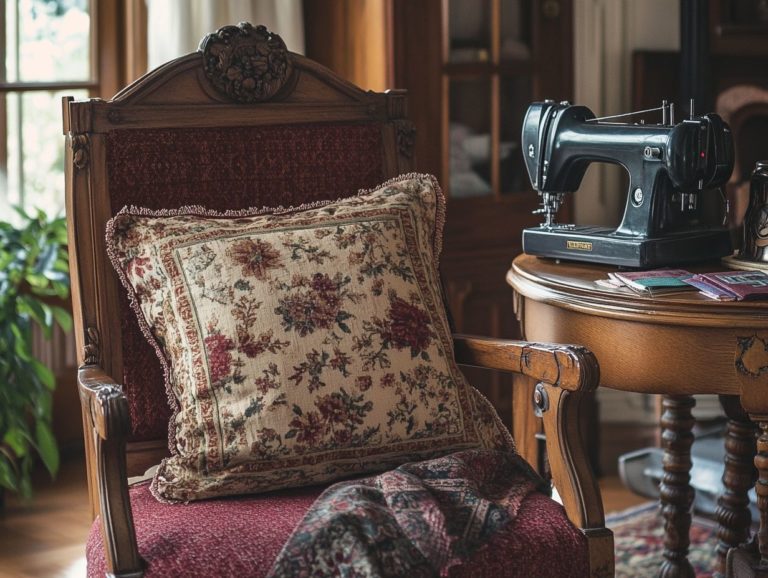5 Tips for Upcycling Vintage Fabrics in Decor
Transforming your home decor with vintage fabrics can rejuvenate your space while highlighting your distinct style.
Here are five essential tips for upcycling those vintage materials, from selecting high-quality fabrics adorned with captivating patterns to exploring innovative techniques.
Embrace this sustainable practice to elevate your decor and contribute positively to the environment while saving some money in the process.
Gain inspiration and discover how to navigate common challenges, ensuring your upcycled creations are both breathtaking and durable.
Contents
- Key Takeaways:
- 1. Choose Quality Fabrics with Unique Patterns
- 2. Consider the Condition and Durability of the Fabric
- 3. Look for Inspiration and Ideas Online
- 4. Experiment with Different Techniques
- 5. Incorporate Upcycled Fabrics into Your Home Decor
- What Is Upcycling and Why Is It Important?
- How Can Upcycling Vintage Fabrics Benefit the Environment?
- What Are Some Common Challenges When Upcycling Vintage Fabrics?
- What Are Some Creative Ways to Use Upcycled Vintage Fabrics in Decor?
- What Are Some Tips for Maintaining and Cleaning Upcycled Vintage Fabric Decor?
- How Can Upcycling Vintage Fabrics Save Money on Home Decor?
- Frequently Asked Questions
Key Takeaways:

- Choose high-quality vintage fabrics with unique patterns to add a special touch to your decor.
- Check the fabric s condition to ensure it will last.
- Find ideas online for creative ways to use vintage fabrics.
1. Choose Quality Fabrics with Unique Patterns
Choosing quality fabrics with unique patterns is essential for your creative home projects. These fabrics enhance your decor and offer a chance to tell a story, adding character to your space.
Among these delights, vintage linens exude a timeless charm that can transform your ordinary items into exquisite statements. Floral handkerchiefs, with their vibrant colors and intricate designs, inject a touch of whimsy into your sewing projects. You can use them for that unique twist you seek.
Selecting fabrics that resonate with your personal style is crucial. Whether you re crafting decorative pillows or DIY bookmarks, the right fabric can dramatically influence the final outcome. Each piece becomes more than just a project; it s a reflection of your individual taste, beautifully bridging creativity and personal expression.
2. Consider the Condition and Durability of the Fabric
When selecting vintage fabrics for your upcycling projects, it s essential to consider their condition and durability. You want to ensure that the pieces you choose will withstand wear and retain their charm, especially when they re included in home decor or sewing projects.
To assess the condition, take a close look at various elements, such as thread count, which often reflects the fabric’s overall quality. A higher thread count usually indicates stronger, more resilient materials, perfect for frequent use.
Be on the lookout for visible signs of wear like thinning areas, fraying edges, or discoloration that could compromise the fabric’s integrity. Durability is key, particularly with antique quilts or tea towels, as these items typically showcase robust construction techniques that enhance their lifespan.
Choose strong, well-preserved fabrics to make your projects look great and last longer.
3. Look for Inspiration and Ideas Online
The internet serves as a treasure trove of inspiration, bursting with countless ideas for upcycling vintage fabrics into stunning home decor and unique fabric crafts. You ll find it easy to discover pieces that will elevate your projects and ignite your inner designer!
By immersing yourself in platforms like Pinterest, Instagram, and various crafting blogs, you can uncover a wealth of innovative ideas that breathe new life into old textiles. Imagine tackling projects such as delightful DIY bookmarks embellished with floral fabrics or charming handkerchief valances that infuse a room with nostalgia.
These projects not only showcase the timeless beauty of vintage patterns but also empower you to add a personal touch to your space. The exploration doesn t end there; with each click, you uncover fresh inspiration, inviting you to experiment and customize your handmade treasures.
4. Experiment with Different Techniques

Experimenting with different sewing techniques using vintage fabric opens a world of creativity, leading to charming projects that reflect your unique style. You can make excellent use of fabric scraps and upcycled materials.
Explore various methods like quilting, patchwork, and appliqu . Transform these timeless textiles into whimsical designs that evoke nostalgia. Quilting adds warmth and texture to your projects. Patchwork allows a playful mix of patterns and colors, resulting in eye-catching pieces. Appliqu lets you sew one piece of fabric onto another for decoration, combining shapes and stitches for a personalized touch.
Embracing these techniques breathes new life into old fabrics. It encourages you to let your imagination soar, resulting in delightful decorative pillows and unique home accents that truly reflect your artistic spirit.
5. Incorporate Upcycled Fabrics into Your Home Decor
Incorporating upcycled fabrics into your home decor elevates the aesthetic appeal of your space while championing sustainable practices. This approach lets you create beautiful, eco-friendly decor that highlights vintage textiles and unique pieces.
Choose items like decorative pillows to infuse a lively pop of color and distinctive texture into your living room. Consider fabric wall art that tells a story and mirrors your personal style it can transform an ordinary space into a creative sanctuary. Even hidden pin cushions made from vibrant scraps can serve a dual purpose, functioning as practical tools while adding brightness to your workspace.
Utilizing such innovative decor reduces your carbon footprint and nurtures a sense of creativity and individuality that mass-produced items cannot match!
What Is Upcycling and Why Is It Important?
Upcycling is all about creatively repurposing vintage fabrics and other materials to craft new, functional items. This practice cuts down on waste and champions sustainable practices essential in today s eco-conscious world, especially in home decor and crafting.
Imagine transforming discarded textiles into chic cushions, eye-catching table runners, or stylish tote bags. Each piece gives new life to what might otherwise languish in landfills. Every item carries a unique story, blending artistry with responsibility toward the environment. By opting for upcycled creations, you can significantly reduce your carbon footprint while infusing your living spaces with character and charm. For inspiration, check out the top 10 vintage fabric patterns to enhance decor.
Incorporating eco-friendly decor into your daily life comes with many benefits, such as minimizing synthetic waste and promoting a more sustainable lifestyle. This ultimately paves the way for a healthier planet!
How Can Upcycling Vintage Fabrics Benefit the Environment?
Upcycling vintage fabrics offers remarkable environmental benefits by reducing waste, conserving resources, and championing sustainable style. Each time you transform discarded materials into exquisite, functional items, you contribute to a more eco-friendly lifestyle.
By creatively reusing materials, you lessen landfill waste. Every piece of upcycled fabric you choose signifies a deliberate decision to divert items from overflowing dumps. This practice also conserves energy that would otherwise be consumed in the often resource-intensive manufacturing of new textiles.
Embracing these sustainable methods showcases your commitment to conscious consumerism. It encourages those around you to rethink their consumption habits. In doing so, you help foster a movement toward environmental stewardship and awareness within your community!
What Are Some Common Challenges When Upcycling Vintage Fabrics?
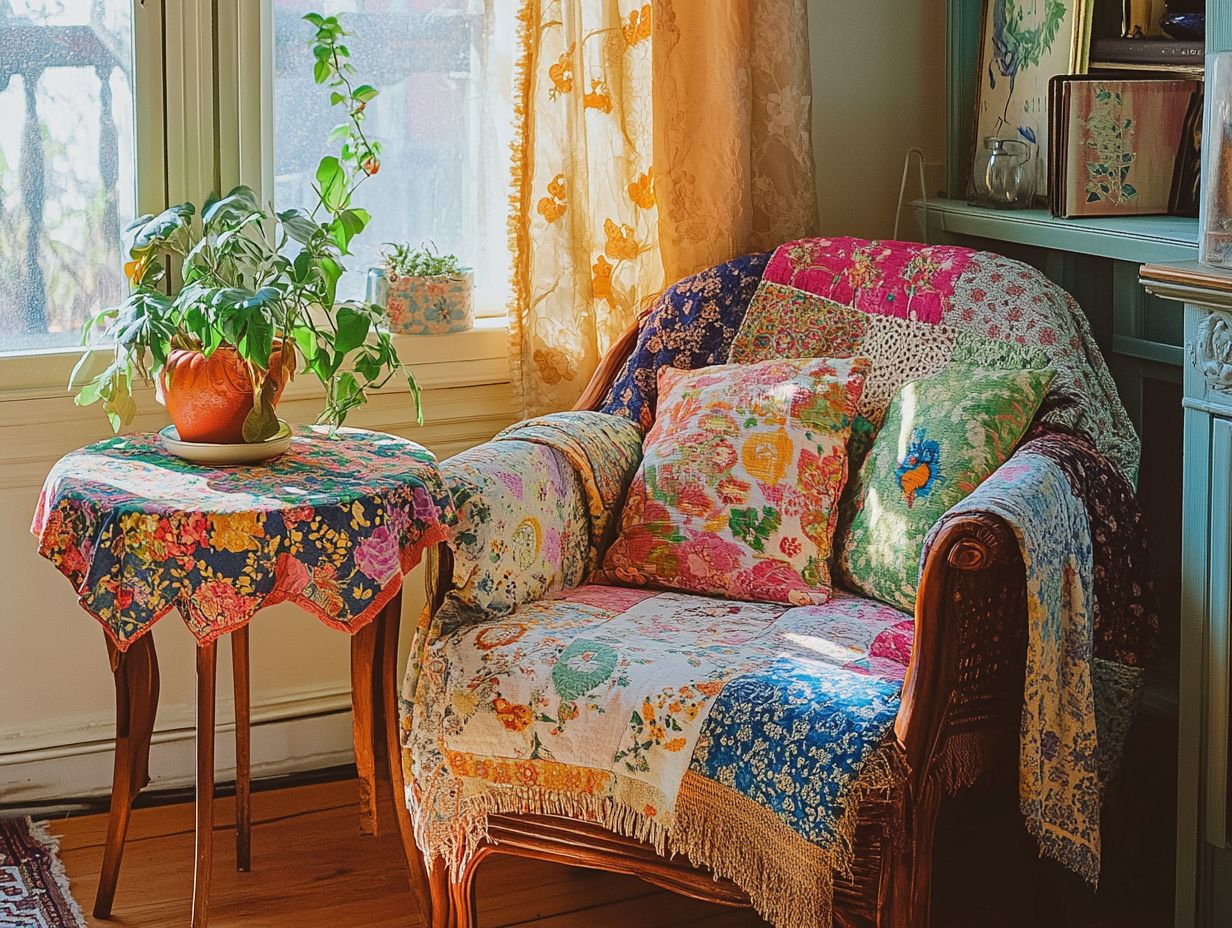
Upcycling vintage fabrics can be a rewarding activity, but it comes with challenges. You ll need to source quality materials, learn the best sewing methods, and tackle unexpected project difficulties.
One big challenge is finding matching sewing notions that fit the unique textures and colors of these fabrics. Vintage materials often differ in weight and drape, requiring special stitches for a polished look.
To make it easier, visit local fabric stores that focus on vintage finds or check out online marketplaces for sewing supplies. Try using testers on scrap pieces to ensure your methods work well without damaging the fabric.
Researching the unique traits of vintage materials is very helpful. This knowledge prepares you for any quirks that may arise during your crafting journey.
What Are Some Creative Ways to Use Upcycled Vintage Fabrics in Decor?
You ll find countless creative ways to use upcycled vintage fabrics in your home decor. Think whimsical decorative pillows or unique DIY bookmarks; each project adds charm and history to your space.
These reclaimed textiles can be transformed into functional pieces like rustic table runners or story-telling wall art. Imagine cozy patchwork quilts that spark conversations filled with nostalgia.
By weaving these vintage pieces into your everyday items, you can enhance your home s aesthetic while promoting sustainability and individuality. Let the past blend beautifully with modern design.
What Are Some Tips for Maintaining and Cleaning Upcycled Vintage Fabric Decor?
Caring for your upcycled vintage fabric decor is essential for its longevity and beauty. Each piece has specific care instructions based on its unique qualities, so pay close attention.
Use gentle cleaning techniques. Most vintage fabrics are delicate and won t survive harsh detergents or aggressive washing. A gentle cycle in cold water with mild detergent works best. For minor stains, a damp cloth for spot cleaning works wonders.
For storage, keep your fabrics in a cool, dry place. Avoid direct sunlight to prevent fading and deterioration. Following these practices helps maintain the beauty of your vintage treasures for future enjoyment.
How Can Upcycling Vintage Fabrics Save Money on Home Decor?
Upcycling vintage fabrics can transform your home decor budget. This approach lets you craft personalized pieces that reflect your unique style.
With creativity, thrifted items like old tablecloths or discarded clothes can become charming cushions or captivating wall art, all for much less than new items. Consider exploring unique uses for vintage fabrics in home decor; while a chic cushion cover might cost over $40, repurposing fabric scraps can give similar results for under $10.
Simple sewing techniques or fabric glue can work wonders. Transform an old quilt into stylish throws or distinctive curtains that showcase your flair for design and budget-friendly choices. Upcycling enhances your home s look and promotes sustainability.
Frequently Asked Questions
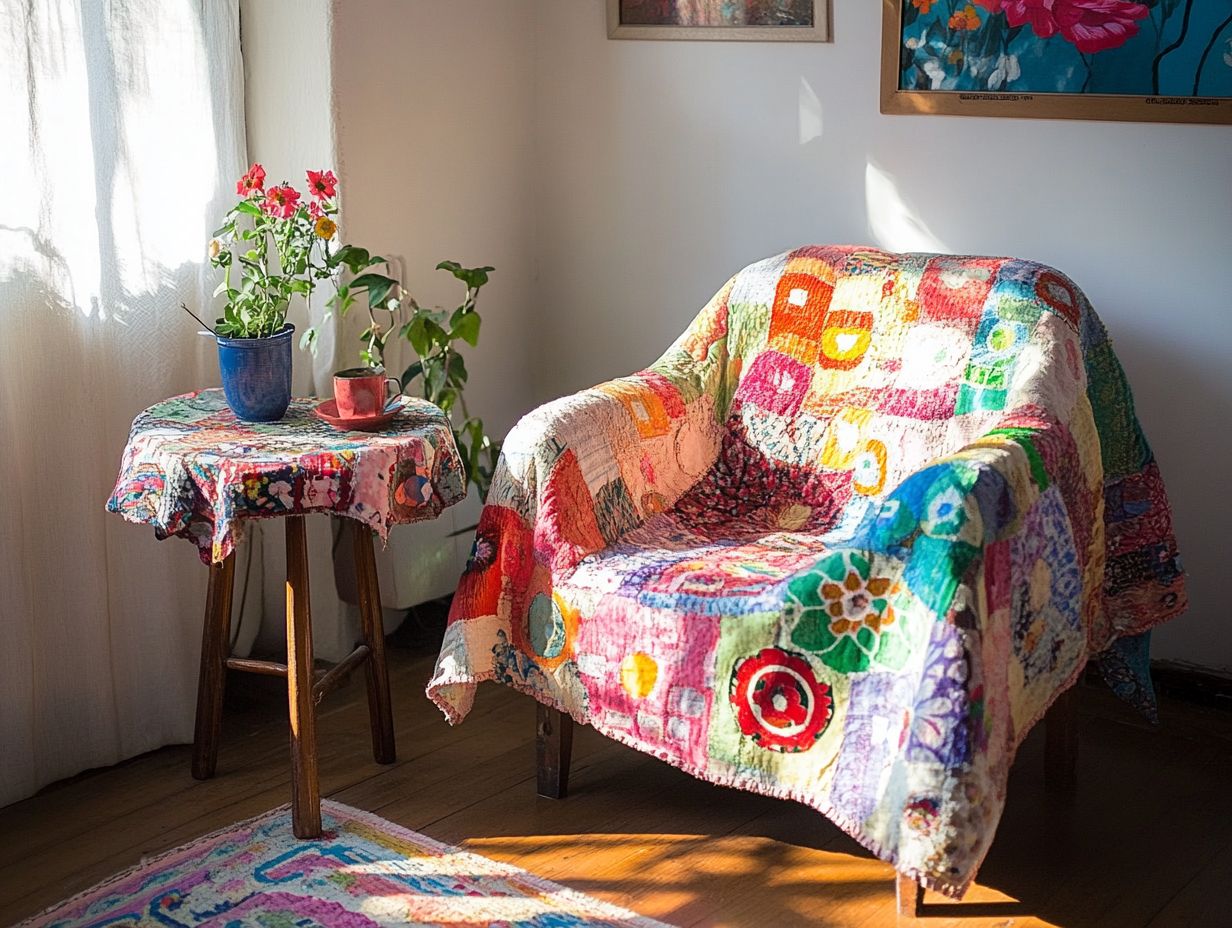
What is upcycling, and why does it matter?
Upcycling means taking things you no longer need and making them useful again. It helps the environment by reducing waste and conserving resources.
Why use vintage fabrics in home decor?
Using vintage fabrics gives your home a unique touch. It also supports sustainable practices by reviving old materials.
How can I add vintage fabrics to my decor?
You can create throw pillows, curtains, or table runners. You can even reupholster old furniture to give it new life!
What should I look for in high-quality vintage fabrics?
Choose fabrics made from natural fibers like cotton, linen, or silk. Always check for damage or stains to ensure they are in good condition.
Can I mix different vintage fabrics?
Absolutely! Mixing patterns and textures adds interest to your decor. Just pick fabrics that match well together.
Any care instructions for upcycled vintage fabric decor?
Follow the care instructions for each fabric. Vintage fabrics are often delicate, so hand washing or a gentle machine cycle is best.

